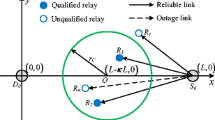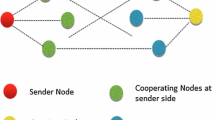Abstract
Optimized cooperative scheduling (OCS) increases the network capacity of the wireless ad hoc network by optimizing relay node selection. This increases the capacity by dividing the long link into too many hops locally and avoids the node failure. OCS decides the best node for the transfer of the file by evaluating its objective function and forming the interference set of the relay node. Random scheduling generalizes the randomization framework to the Signal to Interference plus noise ratio rate-based interference model by dealing with the power allocation problem. It develops a distributed gossip comparison mechanism with the power allocation to maximize the throughput. The comparison of wireless scheduling schemes is done in terms of transmission rate, throughput, jitter, time to schedule packets, latency, end-to-end delay and bandwidth. The performance analysis proves that OCS has high transmission rate, low latency and uses less bandwidth. Random scheduling has high throughput, less time for scheduling of packets, low jitter and smaller at the end to end delay.














Similar content being viewed by others
References
Rasmussen, A., Yu, H., Ruepp, S., Berger, Ms, & Dittmann, L. (2014). Efficient round-robin multicast scheduling for input-queued switches. Proceedings in IET Network, 31, 1–29.
Kaur, A., Singh, H., & Sharma, P. (2014). Bandwidth allocation scheduling algorithms for IEEE 802.16 WiMax Protocol to improve QoS. Proceedings in International Journal of Computer Applications, 98(11), 16–22.
Bai, D. (2015). Asymptotic analysis of online algorithms and improved scheme for the flow shop scheduling problem with release dates. Proceedings in International Journal of Systems Science, 46(11), 256–263.
Bampis, Evripidis, Dürr, Christoph, Kacem, Fadi, & Milis, Ioannis. (2012). Speed scaling with power down scheduling for agreeable deadlines. Proceedings in Sustainable Computing: Informatics and Systems, 2(4), 184–189.
Sheikh, Hafiz Fahad, Ahmad, Ishfaq, Wang, Zhe, & Ranka, Sanjay. (2012). An overview and classification of thermal-aware scheduling techniques for multi-core processing systems. Proceedings in Sustainable Computing: Informatics and Systems, 2(3), 151–169.
Huang, Huang, Fan, Ming, & Quan, Gang. (2013). Thermal aware overall energy minimization scheduling for hard real-time systems. Proceedings in Sustainable Computing: Informatics and Systems, 3(4), 274–285.
Lee, H. W., Modiano, E., & Le, L. B. (2012). Distributed throughput maximization in wireless network via random power allocation. Proceedings in IEEE Transactions on Mobile Computing, 11(4), 77–590.
Zhang, Luna Mingyi, Li, Keqin, Lo, Dan Chia-Tien, & Zhang, Yanqing. (2013). Energy-efficient task scheduling algorithms on heterogeneous computers with continuous and discrete speeds. Proceedings in Sustainable Computing: Informatics and Systems, 3(2), 109–118.
Cruz-Chávez, M. A. (2015). Neighbourhood generation mechanism applied in simulated annealing to job shop scheduling problems. Proceedings in International Journal of Systems Science, 46(15), 546–557.
Nandhini, R., & Devarajan, N. (2014). Comparison for wimax scheduling algorithms and proposal quality of service improvement in wimax network. Proceedings in American Journal of Applied Sciences, 11(1), 8–16.
Huang, R. H., Yang, C. L., & Hsu, C. T. (2015). Multi-objective two-stage multiprocessor flow shop scheduling: A subgroup particle swarm optimisation approach. Proceedings in International Journal of Systems Science, 46(16), 745–758.
Wang, S. & Liu, M. (2016). Two-machine flow shop scheduling integrated with preventive maintenance planning. Proceedings in International Journal of Systems Science, 47(3), 325–336.
Li, W. & Li, S. (2015). Online batch scheduling of equal-length jobs on two identical batch machines to maximise the number of early jobs. Proceedings in International Journal of Systems Science, 46(4), 529–538.
He, Y. & Sun, L. (2015). One-machine scheduling problems with deteriorating jobs and position-dependent learning effects under group technology considerations. Proceedings in International Journal of Systems Science, 46(7), 233–244.
Author information
Authors and Affiliations
Corresponding author
Rights and permissions
About this article
Cite this article
Rosy Salomi Victoria, D. Optimized Cooperative and Random Schedulings Packet Transmissions and Comparison of Their Parameters. Wireless Pers Commun 98, 857–878 (2018). https://doi.org/10.1007/s11277-017-4898-4
Published:
Issue Date:
DOI: https://doi.org/10.1007/s11277-017-4898-4




